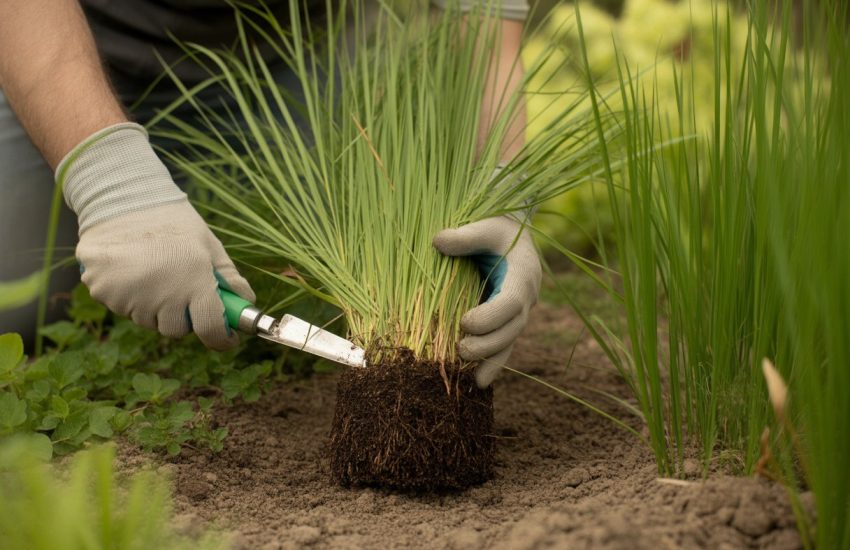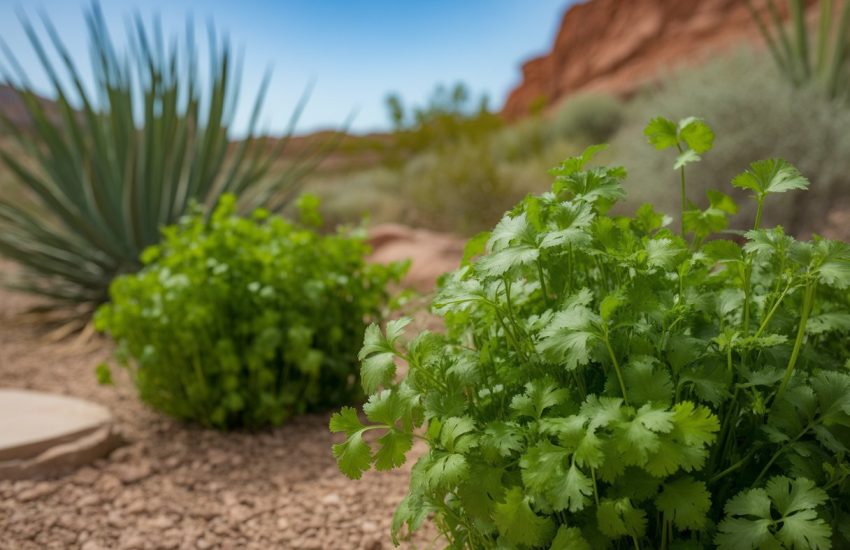Brussel Sprouts from Seed: A Beginner’s Guide
Brussels sprouts are a nutritious and delicious vegetable that can be grown from seed. Growing brussels sprouts from seed is a great way to ensure that the plants are healthy and free from disease. It also allows for greater control over the growing conditions, which can result in a better harvest.
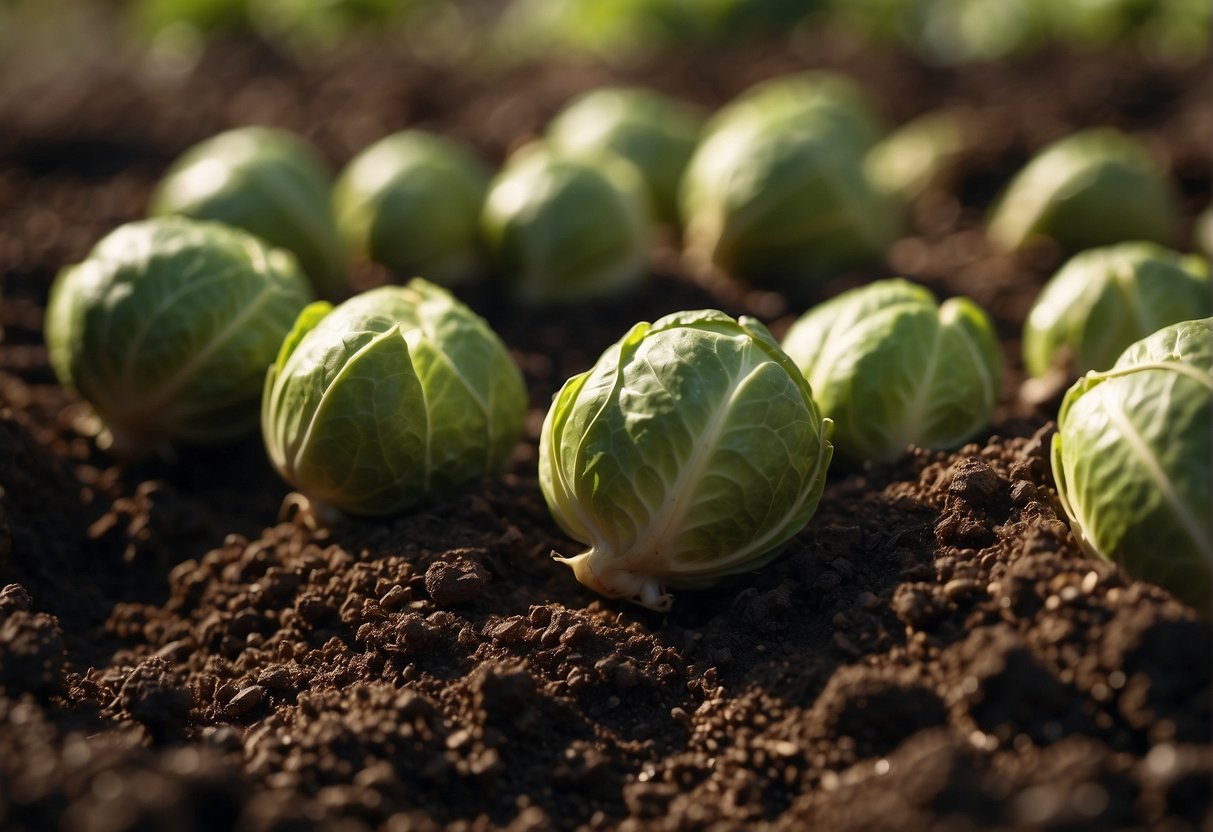
To grow brussels sprouts from seed, it is important to start with high-quality seeds. Look for seeds that are labeled as disease-resistant and choose a variety that is suited to the growing conditions in your area. Brussels sprouts prefer cool weather and require a long growing season, so it is important to plant them early in the spring or late in the summer.
Once you have your seeds, you can start them indoors or directly in the garden. Starting them indoors allows for greater control over the growing conditions and can result in stronger seedlings. When planting directly in the garden, it is important to prepare the soil by adding compost or other organic matter to improve drainage and fertility. With the right care and attention, growing brussels sprouts from seed can be a rewarding experience that results in a bountiful harvest.
Getting Started with Brussels Sprouts
Brussels sprouts are a nutritious and delicious vegetable that can be grown from seed. If you’re interested in growing your own Brussels sprouts, here are some tips to get you started.
Choosing the Right Varieties
There are many varieties of Brussels sprouts to choose from, but some popular options include Long Island Improved and Jade Cross. Long Island Improved is a classic variety that produces large, flavorful sprouts. Jade Cross is a newer variety that is known for its disease resistance and early maturity. When choosing a variety, consider factors such as taste, yield, and disease resistance.
Understanding Soil and Climate Needs
Brussels sprouts prefer full sun and well-drained soil with a pH between 6.0 and 7.5. The soil temperature should be between 45°F and 80°F for optimal growth. If your soil is too acidic, add lime to raise the pH. If it’s too alkaline, add sulfur to lower the pH. Brussels sprouts also prefer cooler temperatures, so they are best grown in the fall or early spring.
When planting Brussels sprouts, make sure to give them plenty of space to grow. They should be planted 18-24 inches apart and should be watered regularly to keep the soil moist but not waterlogged.
By following these tips, you can successfully grow Brussels sprouts from seed and enjoy a delicious and nutritious crop.
Planting and Germination
Sowing Seeds Indoors
To grow brussel sprouts from seed, it is recommended to start the seeds indoors 6-8 weeks before the last frost date in the growing season. Fill a container with seed-starting mix and plant the seeds 1/4 inch deep. Keep the soil moist and maintain a temperature between 60-70°F for optimal germination.
Once the seedlings have sprouted, provide them with plenty of sunlight or grow lights and keep the temperature around 70°F. When the seedlings have grown their first true leaves, thin them out so each one has enough space to grow properly.
Transplanting Seedlings
When the seedlings are 4-6 weeks old and have grown to about 4 inches tall, they are ready to be transplanted outdoors. Choose a spot with full sun and well-draining soil.
Before transplanting, harden off the seedlings by gradually exposing them to outdoor conditions over the course of a week. Plant the seedlings in rows spaced 2-3 feet apart and 2 feet between each plant.
Cover the seedlings with plastic to protect them from heat and cold. Fertilize the plants with a balanced fertilizer every 3-4 weeks and water them regularly.
Brussel sprouts typically take 90-100 days to mature, so plan accordingly. With proper care and attention, brussel sprouts grown from seed can produce a bountiful harvest.
Caring for Brussels Sprouts Plants
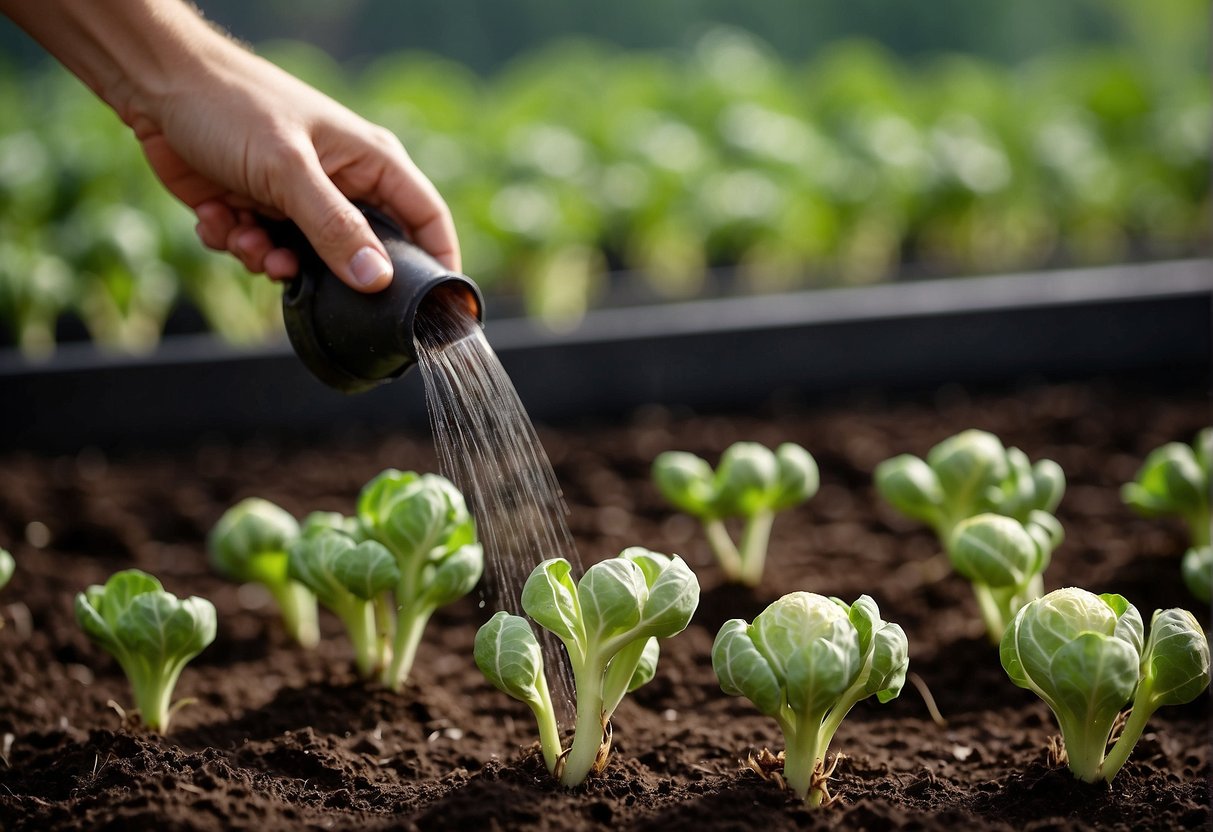
Brussels sprouts are a cool-season crop that requires proper care to thrive and produce abundant yields. In this section, we will discuss the essential aspects of caring for Brussels sprouts plants.
Watering and Nutrients
Brussels sprouts plants require consistent moisture to grow well. Ensure the soil is moist but not waterlogged. Water the plants deeply at least once a week, especially during dry spells. It is also essential to provide the plants with adequate nutrients. Brussels sprouts require high levels of nitrogen to grow well. Use an organic fertilizer high in nitrogen to feed the plants regularly. Mulching around the plants with organic matter can also help retain soil moisture and provide nutrients.
Protecting from Pests and Diseases
Brussels sprouts plants are susceptible to various pests and diseases, such as aphids, cabbage worms, loopers, and clubroot. It is essential to monitor the plants regularly for signs of infestation and take appropriate measures to control them. Row covers can be used to protect the plants from pests. Organic insecticides can also be used to control pests. Fungal diseases can be prevented by ensuring proper air circulation around the plants and avoiding overhead watering. It is also crucial to remove any infected leaves promptly.
In conclusion, caring for Brussels sprouts plants involves providing them with adequate water and nutrients, and protecting them from pests and diseases. By following these essential care practices, gardeners can enjoy a bountiful harvest of nutritious Brussels sprouts.
Harvesting and Storing

Determining Harvest Time
Harvesting brussel sprouts requires careful observation and timing. The sprouts should be harvested when they reach a diameter of 1 to 2 inches. This usually occurs 90 to 180 days after planting, depending on the variety and growing conditions.
Fall frost can improve the taste of brussel sprouts, but it can also damage the plants. If a fall frost is expected, it is best to harvest the sprouts before the frost arrives.
Post-Harvest Handling
After harvesting, remove the sprouts from the stalks by twisting them off gently. Avoid pulling or cutting the sprouts, as this can damage the stalks and reduce their yield in future harvests.
To store the sprouts, remove any damaged or yellowed leaves and rinse them in cold water. They can be stored in the refrigerator for up to two weeks, or blanched and frozen for up to six months.
Brussel sprouts can be eaten raw or roasted. Raw sprouts have a slightly bitter taste and a crunchy texture, while roasted sprouts are sweeter and have a softer texture.
In summary, harvesting and storing brussel sprouts requires careful timing and attention to detail. By following these guidelines, you can ensure a bountiful harvest and delicious brussel sprouts all winter long.
Extending the Growing Season
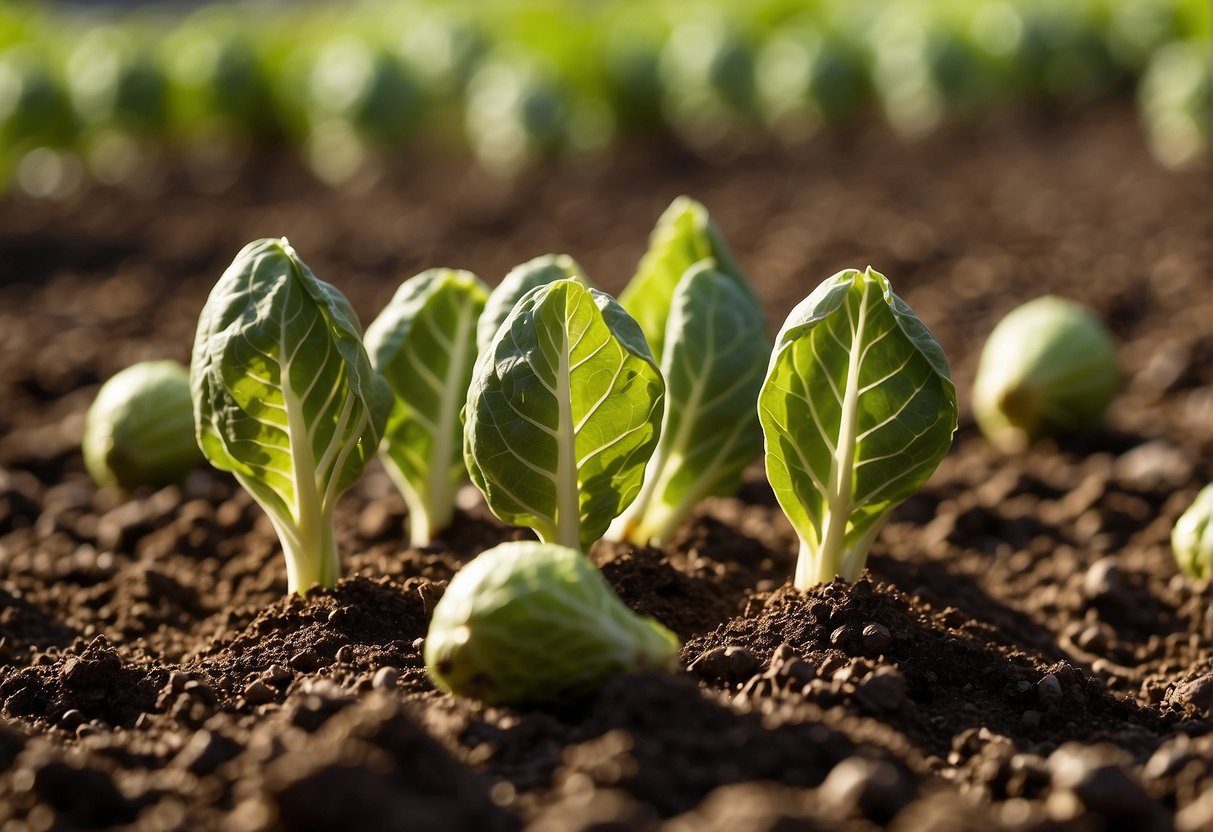
Brussel sprouts are a cool-weather crop that can be grown in the fall and winter months. However, extending the growing season can provide a longer harvest window and increase yields.
One way to extend the growing season is to start seeds indoors in May. This allows for earlier planting and a longer growing season. Brussel sprouts take around 90-100 days to mature, so starting seeds in May will allow for a fall harvest.
Another method is to use row covers or cold frames to protect the plants from frost. This can extend the growing season into the winter months, allowing for a longer harvest window.
It’s important to note that brussel sprouts prefer cool weather and can become bitter if grown in hot temperatures. Therefore, it’s best to plant them in the late summer or early fall for a fall harvest.
In summary, extending the growing season for brussel sprouts can be achieved by starting seeds indoors in May and using row covers or cold frames to protect the plants from frost. This can provide a longer harvest window and increase yields of this cool-weather crop.
Frequently Asked Questions

How can you grow Brussels sprouts from seed indoors?
To grow Brussels sprouts from seed indoors, start by filling a seed tray with compost and sowing the seeds at a depth of 1/4 inch. Keep the soil moist and at a temperature of around 60-65°F until the seeds germinate, which usually takes about 7-10 days. Once the seedlings have developed their second set of leaves, transplant them into individual pots and continue to grow them indoors until they are ready to be planted outside.
What are the ideal companion plants for Brussels sprouts?
Brussels sprouts grow well with a variety of plants, including beets, carrots, celery, chamomile, dill, garlic, hyssop, onions, and sage. Avoid planting them near strawberries, tomatoes, or pole beans.
At what stage of growth do Brussels sprouts plants typically need transplanting?
Brussels sprouts plants typically need transplanting when they have developed their second set of leaves. This usually occurs around 3-4 weeks after sowing the seeds.
When is the best time to plant Brussels sprouts seeds for a holiday harvest?
To have Brussels sprouts ready for a holiday harvest, plant seeds indoors in mid to late March and transplant them outside in late May or early June. This will ensure that the plants mature in time for a late fall or early winter harvest.
How many Brussels sprouts can you expect to harvest from a single plant?
On average, you can expect to harvest around 50-100 Brussels sprouts from a single plant. However, this can vary depending on the variety of Brussels sprouts and growing conditions.
Are Brussels sprouts a perennial plant, and will they grow back each year?
Brussels sprouts are not a perennial plant and will not grow back each year. They are a biennial plant, meaning they complete their life cycle over two years. In the first year, they grow leaves and a stem, and in the second year, they produce flowers and seeds.

